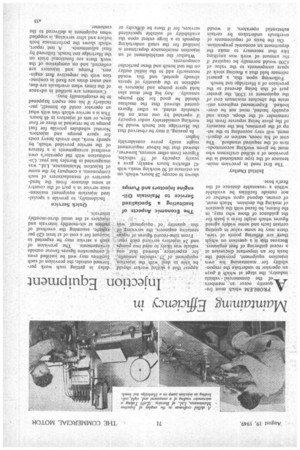Maintaining E ciency in
Page 51

If you've noticed an error in this article please click here to report it so we can fix it.
Injection Equipment
APROBLEM which must frequently occur, An members of the Commercial vehicle industry, the stage at which it .pays an operator to undertake the responsibility for ' maintaining his , own injection equipment, provided the basis for an important discussion at a recent gathering of fleet engineers. Because this is a question on which there are differing points of view, there may be some value in quoting certain facts and some widely agreed figures which might form a basis for the guidance of those who may, in the future, be faced with the question of making the decision. Much must, of course, depend upon whether or not outside facilities be available within a reasonable distance of the fleet's base.
Initial Outlay The first need in precision maintenance of the type mentioned is the provision of a skilled craftsman who must be given working accommodation of. the required standard. The cost of his room, section or department, will vary according to the setup of the premises, but, the necessity of the place being separate from the remainder of the shops, clean and equably heated, must not be overlooked. Experienced engineers estimate the absolute minimum cost of the equipment at £500, the greater part of this being devoted to the provision of a Hartridge test bench.
Following upon this, a general estimate held that a floating stock of spare components to the value of £200 would normally be required if the amount of work was anything like that necessary to make the department an economic proposition.
On the basis of requirements of overhauls undertaken by certain substantial operators, it would
appear that a skilled. worker should
be 'able to deal with the injection , equipment of 75 :vehicles annually, for experience_ showed that one
vehicle was likely to need two punii-iS
, and 24 injectorsserviced each year , From time record figUres of repre sentative engineers, the servicing of
this qUantity equipinent ,waS
shown to occupy 28 hours, which, on an estimate.of 50 working weeks with 42 effective hours weekly, gave a yearly capacity of 75 vehicles. Figures from other sources, however, showed that the labour' requirement might easily prove considerably higher.
In passing, it may be observed that the Hartridge test bench would be working considerably under capacity 'if operated by one man' on the schedule stated, as other figures quoted showed that the machine should be good for 500 pumps annually.' Any big fleet must also hold spare pumps and injectors in addition to the quantity of spares already quoted, and this would necessarily add to the initial outlay on the test bench and these particular components.
Whether the establishment of an injection maintenance department is' justified for the small undertaking depends to a large extent upon the availability of suitable, specialized services, for if there be difficulty or delay in getting such work performed outside, the provision of such facilities maywell be justified even if comparative figures favoiii outside arrangements. The provision of such a service may beexpected to account for a cost of at least £20 per velaiete, assuming the overhaul of putiips at six-monthly intervals and injectors at the usual three-monthly intervals. _
Quick Service Incidentally, to provide a specialized injection equipment' maintenance service in a part of the country at some distance from the headquarters of manufacturers of such components, a company by the name of Injection Maintenance, Ltd., was inaugurated in Burnley last year. Coordination withthe operator's own overhaul arrangements is a feature of the service provided which, by speedy work, also avoids heavy costs for spare pumps and injectors. Normal schedules provide for fuel pumps to be returned in three or four days, or sets of injectors in 48 hours. This is a service which vies with what an operator could do himself, particularly if his one expert happened to be exceptionally busy.
Customers are notified in advance of the times when overhauls are due, and exact dates are fixed in conjunction with the respective fleet engineers. Pumps and injectors are collected, and on completion of the work there are functional trials on the Hartridge test bench, followed by final adjustments. A test report, which shows the performance both before and after servicing, is supplied when equipment is delivered to the customer.




















































































